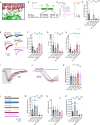This is a preprint.
Neurotransmitter release is triggered by a calcium-induced rearrangement in the Synaptotagmin-1/SNARE complex primary interface
- PMID: 38948868
- PMCID: PMC11213007
- DOI: 10.1101/2024.06.17.599435
Neurotransmitter release is triggered by a calcium-induced rearrangement in the Synaptotagmin-1/SNARE complex primary interface
Update in
-
Neurotransmitter release is triggered by a calcium-induced rearrangement in the Synaptotagmin-1/SNARE complex primary interface.Proc Natl Acad Sci U S A. 2024 Oct 15;121(42):e2409636121. doi: 10.1073/pnas.2409636121. Epub 2024 Oct 7. Proc Natl Acad Sci U S A. 2024. PMID: 39374398 Free PMC article.
Abstract
The Ca2+ sensor synaptotagmin-1 triggers neurotransmitter release together with the neuronal SNARE complex formed by syntaxin-1, SNAP25 and synaptobrevin. Moreover, synaptotagmin-1 increases synaptic vesicle priming and impairs spontaneous vesicle release. The synaptotagmin-1 C2B domain binds to the SNARE complex through a primary interface via two regions (I and II), but how exactly this interface mediates distinct functions of synaptotagmin-1, and the mechanism underlying Ca2+-triggering of release is unknown. Using mutagenesis and electrophysiological experiments, we show that region II is functionally and spatially subdivided: binding of C2B domain arginines to SNAP-25 acidic residues at one face of region II is crucial for Ca2+-evoked release but not for vesicle priming or clamping of spontaneous release, whereas other SNAP-25 and syntaxin-1 acidic residues at the other face mediate priming and clamping of spontaneous release but not evoked release. Mutations that disrupt region I impair the priming and clamping functions of synaptotagmin-1 while, strikingly, mutations that enhance binding through this region increase vesicle priming and clamping of spontaneous release, but strongly inhibit evoked release and vesicle fusogenicity. These results support previous findings that the primary interface mediates the functions of synaptotagmin-1 in vesicle priming and clamping of spontaneous release, and, importantly, show that Ca2+-triggering of release requires a rearrangement of the primary interface involving dissociation of region I, while region II remains bound. Together with modeling and biophysical studies presented in the accompanying paper, our data suggest a model whereby this rearrangement pulls the SNARE complex to facilitate fast synaptic vesicle fusion.
Keywords: Neuroscience; SNAREs; electrophysiology; neurotransmitter release; structure function analysis; synaptic vesicle fusion; synaptotagmin.
Conflict of interest statement
Declaration of interests The authors declare no competing interests.
Figures






References
-
- Sutton R. B., Fasshauer D., Jahn R., Brunger A. T., Crystal structure of a SNARE complex involved in synaptic exocytosis at 2.4 A resolution. Nature 395, 347–353 (1998). - PubMed
Publication types
Grants and funding
LinkOut - more resources
Full Text Sources
Miscellaneous
